Motorola Droid RAZR Review - A Better Clad Bionic
by Brian Klug on December 16, 2011 2:01 AM EST- Posted in
- Smartphones
- Droid
- LTE
- 4G
- Motorola
- Android
- Mobile
- Droid RAZR
- motorola droid RAZR
Cellular Connectivity
We’ve already outlined much of what there is to say about the combination of Qualcomm’s MDM6600 and Motorola’s on Wrigley LTE baseband inside the Droid Bionic review, but it still bears going over. Just like the Bionic, MDM6600 handles 1x voice and data, EVDO Rev.A 3G data, and Wrigley supplies LTE connectivity. In fact, the RAZR has a virtually identical cellular architecture to the Bionic, at least as far as I can tell. There’s the same Infineon transciever for LTE, Skyworks 700 MHz power amp, and combination MCP DRAM+NAND packages for the MDM6600 and Wrigley basebands.
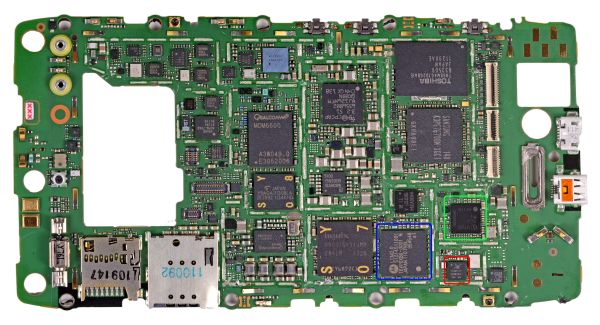
Motorola Wrigley LTE baseband, Intel/Infineon transceiver, Skyworks PA encircled in blue, green, and red respectively. (Original image courtesy iFixit)
I wasn’t totally satisfied in the Bionic piece that I proved the Wrigley baseband was UE Category 2, so I did some more poking this time with the RAZR and found the same exact architecture for administration and configuration as previously. Wrigley is actually a very interesting little part, consisting of an ARM926EJ-S running at 380 MHz:
cat /proc/cpuinfoProcessor : ARM926EJ-S rev 5 (v5l)BogoMIPS : 189.57Features : swp half thumb fastmult edsp javaCPU implementer : 0x41CPU architecture: 5TEJCPU variant : 0x0CPU part : 0x926CPU revision : 5Hardware : Wrigley 3G DatacardLTE
Oddly enough there are many places where it refers to itself as a “3G Datacard” even though it’s clearly designed only to work with LTE. The thing is just running GNU Linux:
uname -aLinux localhost 2.6.29-omap1 #2 Tue Oct 25 20:02:46 CDT 2011 armv5tejl GNU/Linux
The reality is that almost all black boxes inside mobile phones end up revealing something similar at their heart if you poke around enough. If we were counting the number of ARM parts onboard your average smartphone I wouldn’t be surprised to see at least 4 or 5 different ARM cores.
Anyhow, the RAZR doesn’t have a nice mib default xml file that nicely spells out the LTE UE category like the Bionic did, but the default set of mibs being set does include the Verizon EARFCN of 5230 which corresponds to LTE band 13. After lots of poking around, I found a way to query the UE category directly:
shell@(unknown):/system/bin$ iwaconfig -g -x 33163MOID 0x818b Name LTE_MGMT_RRC_UE_CATEGORY MIB OIDvalue=2 [0x02]
So life is good and our earlier claims that Motorola Wrigley (with lots of TI references inside) is indeed LTE UE Category 2. As a reminder, other devices based on MDM9x00, LG L2000, and Samsung’s CMC220 are UE Category 3.
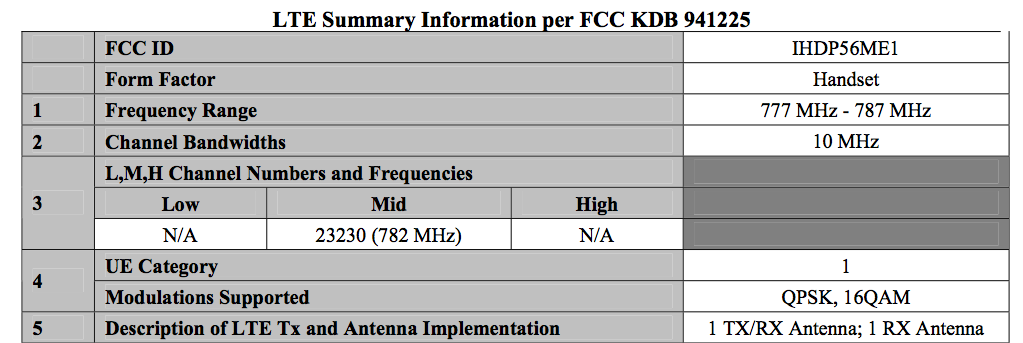
Oddly enough, just like the Bionic the official FCC filing summary information for the LTE side of the RAZR erroneously states that it is UE Category 1. As usual we get the normal pretty diagram with the location of antennas, and interestingly enough the LTE antenna is up at the top on the RAZR instead of in a combined module at the very bottom.
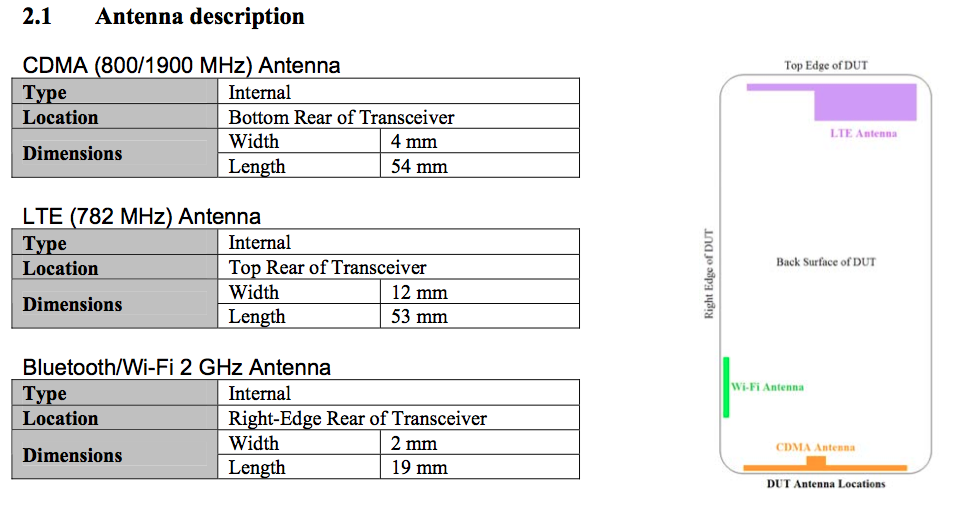
We’ve been doing a pretty good job keeping track of cellular throughput by running a bunch of speedtests, getting that data off, and making some graphs. The RAZR isn’t spared this treatment at all, and I ran 510 tests on Verizon 4G LTE in my own market in Tucson AZ and while on a trip to Los Angeles, CA.
Downstream Stats (Mbps)Avg: 14.701; Max: 36.267; Min: 0.068, StDev: 6.594Upstream Stats (Mbps)Avg: 6.912; Max: 20.719; Min: 0.084, StDev: 3.707Latency Stats (ms)Avg: 80.990; Max: 196; Min: 34, StDev: 17.499
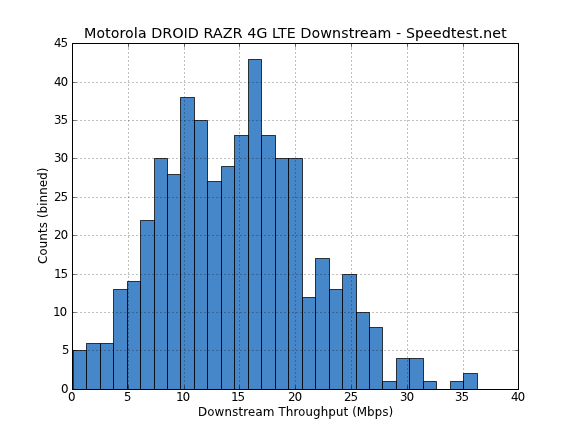
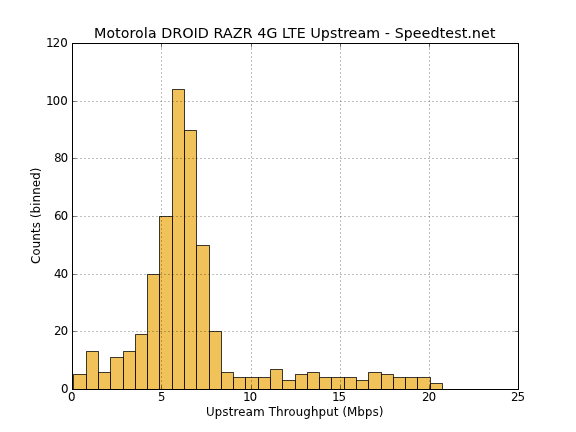
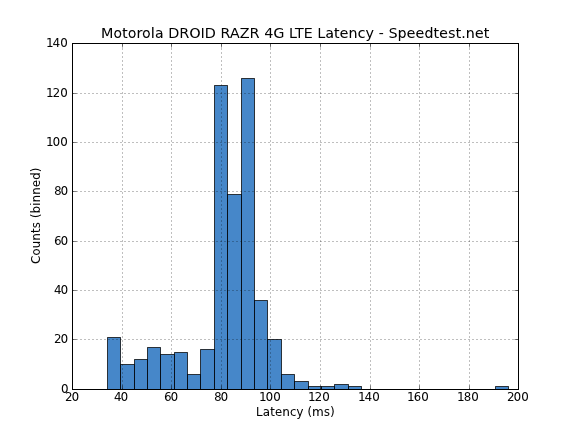
The histograms themselves look a lot like what we’ve seen already out of Verizon’s 4G LTE network on other smartphones, which again uses 10 MHz FDD on LTE band 13. I’ve seen numerous other people hit speeds above 50 Mbps on category 3 devices in favorable network conditions, but obviously the RAZR being category 2 does preclude it hitting those speeds.
Like the Bionic, the RAZR also gives you a nice and easily accessible network option to use either LTE/CDMA or just CDMA. Unfortunately again there’s no way to force data on only LTE and avoid handing over, but in practice I rarely saw the RAZR do a hard handover unless network conditions completely precluded using LTE.
I was pleased with myself when I used the Bionic that it was possible to look at LTE signal power (RSCP) and the channel quality indicator (CQI) by just running logcat and grepping the radio status daemon that Motorola wrote for updating their bar visualization. Unfortunately in this newer version of Blur that logging debug output and functionality is no longer, and if you look closely you’ll also notice they went from 4 bars to 5. There’s another way to view those metrics but it involves having shell on the baseband and directly querying the MIBs that correspond to all the LTE signal quality figures of merit. It’s still possible but much more involved. The upside of course is that I was able to confirm the RAZR correctly reports those bars based on signal power and quality, unlike most of the other LTE handsets which just look at power.
Lastly, the Droid RAZR XT912 Motodev page notes that the phone has WCDMA 850/900/1900/2100 connectivity courtesy of the MDM6600. However, the shipping Droid RAZR has WCDMA disabled and corresponding lines commented out inside build.prop for the WCDMA components. Considering the existence of the RAZR XT910 (sans “Droid”) with WCDMA and GSM I think it’s fairly easy to predict that a world mode variant with LTE is coming sooner rather than later. I wouldn’t mind having a RAZR that works on AT&T WCDMA, that’s for sure.










76 Comments
View All Comments
ananduser - Friday, December 16, 2011 - link
Much better than the one on The Verge.GrizzledYoungMan - Friday, December 16, 2011 - link
As usual, the reviews of wireless devices here kick ass. I'm not really interested in this phone - the wide bezel around the screen and the motoblur really bugged me - but it is a treat to read something about it that amounts to more than "how is this not like an iphone?"Looking forward to the Galaxy Nexus review, even though I'll likely already own it by the time your review is published. On principle, I can't bring myself to buy any phone loaded down with skins and bloatware, so there's only really one Android phone choice for me.
Maybe I'm just surly this morning, but Motorola's latest industrial design language really isn't doing it for me. It has this Tron Legacy-esque cheesy vibe to it that is going to age quickly and poorly, I think. By comparison, it seems like Samsung and Nokia are on the right track, focusing on designs that are respectively helpful and pragmatic, and personal and pleasurable to use.
Apple has been disappointing lately on design. The iPhone 4S body still looks great, but their software is getting more decorated and literal with every revision. I like a lot of things about the 4S - especially the camera - but the software was a huge disappointment.
zeagus - Friday, December 16, 2011 - link
Keep in mind the Galaxy Nexus is suffering some controversy vs. the "Pure Google" GSM version by having had VZW remove Google Wallet from it and adding My Verizon Mobile and Backup Assistant..medi01 - Friday, December 16, 2011 - link
Why do mentioned manufacturers: Appl,Motorol,Noki need battery "tradeoffs" due to slimness and lightness, while Samsung doesn't? Hard to follow on this one.JasonInofuentes - Friday, December 16, 2011 - link
Samsung makes an entirely different trade off, plastics. Sammy has perfected thin, hard plastics in their pursuit of slim, lightweight phones. The cost is feel. The RAZR feels as expensive as it is, the Samsung phones feel like shiny, low cost plastic. That said, using light plastics hasn't stopped Samsung from producing attractive designs, and though the plastics can scuff easily they are otherwise quite durable.TedG - Friday, December 16, 2011 - link
I got sick of waiting for the Nexis (or iphone 5) and purchased the Razr about a month ago upgrading from the Droid X. In real life use it is pretty nice. It is quick responding and well built. The camera to me is just OK. I got a widget that turns the 4g off most of the time extending the battery life dramatically. Overall I really like this phone.loribeth - Tuesday, December 27, 2011 - link
I wonder if I turn off my 4G, my hot spot would stay connected?geniekid - Friday, December 16, 2011 - link
Two things.1) I second lemmo's request for an audio quality section like the one for the GS2 review. That particular review revealed some nasty things about interference and a poor codec that completely turned me off to the GS2.
2) I completely agree about the importance of battery life. It's really the only complaint I have about my 1.5 year old Incredible running Cyanogen. Give me the same phone with 2x the battery life and I'd gladly take it over anything else in the market right now.
lemmo - Saturday, December 17, 2011 - link
Thanks geniekid, yep I reckon audio testing will be a real diferentiating factor for Anandtech, as no other sites do it... similar to Anand's battery testing methodology which set the reviews aside from all the rest.Maybe they will do a comparative audio test with other phones when they do the Nexus review...?
ecuador - Friday, December 16, 2011 - link
After so many Android reviews I am still waiting for Anandtech to review the only phone & OS I have tried that seems to me clearly better than iOS. I am talking about the Nokia N9 with MeeGo which blew me away so much when I tried it I bought it immediately despite the somewhat steep price. Am I alone to being unimpressed by most Android phones?